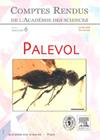Chondrichthyan and osteichthyan fauna from the middle Miocene deposits of Palasava, Kutch, India:implication for paleoenvironment and paleobiogeography
IF 1.3
4区 地球科学
Q3 PALEONTOLOGY
引用次数: 0
Abstract
The Neogene of Kutch, India is well known for its rich marine and terrestrial vertebrate assemblages. However, the data of piscean fauna from the middle Miocene of India is very scarce. We report here additional chondrichthyan and osteichthyan remains from the middle Miocene deposit of Chhasra Formation, Palasava site, Kutch, Gujarat, India. The elasmobranchs include Carcharhinus Blainville, 1816 (C. brevipinna (Müller & Henle, 1839), C. falciformis (Müller & Henle, 1839), C. cf. leucas, C. aff. perezi, Carcharhinus sp.), Negaprion Whitley, 1940 (Negaprion sp.), Aetobatus Blainville, 1816 (Aetobatus sp.), Myliobatis Cuvier, 1816 (Myliobatis sp.), Dasyatis Rafinesque, 1810 (D. probsti Cappetta, 1970, D. rugosa Probst, 1877), Himantura Müller & Henle, 1837 (H. menoni Sahni & Mehrotra, 1981), Pastinachus Rüppell, 1829 (Pastinachus sp.), and Taeniurops Garman, 1913 (Taeniurops sp.). The teleosts of Palasava are represented by four families including Bagridae Bleeker, 1858, Channidae Fowler, 1934, Characidae Latreille, 1925 and Cyprinidae Cuvier, 1817. Sørensen-Dice coefficient data of Palasava elasmobranchs show a good similarity index with their counterparts in the Mediterranean Sea suggesting the existence of short-lived reopening of the marine pathway. However, a much higher faunal affinity with those of Eastern Pacific indicates a gradual shift in migration path through the Pacific Ocean to Indo-Pacific region after the permanent landbridge was formed. The vertebrate fauna from the Palasava suggests a coastal, marginal marine, near-shore littoral to neritic environment of deposition with the influence of freshwater riverine system. The integration of the floras and faunas from Palasava locality indicates the presence of warm, humid/wet, tropical to sub-tropical environmental conditions during the middle Miocene.印度库奇Palasava中中新世沉积物中的软骨鱼和骨鱼动物群:古环境和古生物地理意义
印度库奇的新近纪以其丰富的海洋和陆地脊椎动物群落而闻名。然而,关于印度中新世中期的鱼类动物群的资料非常稀少。本文报道了在印度古吉拉特邦Kutch Palasava遗址Chhasra组中新世中期沉积物中发现的软骨鱼目和骨鱼目化石。elasmo分支包括Carcharhinus Blainville, 1816年(C. brevipinna (m ller & Henle, 1839年),C. cfleucas, C. affer . perezi, Carcharhinus sp.), Negaprion Whitley, 1940年(Negaprion sp.), Aetobatus Blainville, 1816年(Aetobatus sp.), Myliobatis Cuvier, 1816年(Myliobatis sp.), Dasyatis Rafinesque, 1810年(D. probsti Cappetta, 1970年,D. rugosa Probst, 1877年),Himantura m ller & Henle, 1837年(H. menoni Sahni & Mehrotra, 1981年),Pastinachus rpell,1829年(Pastinachus sp.)和Taeniurops Garman, 1913年(-Taeniurops sp.)Palasava的硬骨鱼由四个科代表,包括Bagridae Bleeker, 1858年,Channidae Fowler, 1934年,charidae Latreille, 1925年和Cyprinidae Cuvier, 1817年。elasmobranchs的Sørensen-Dice系数数据显示,它们与地中海的同类物种具有良好的相似指数,表明存在短暂的海洋通道重新开放。然而,与东太平洋的动物群亲和力要高得多,这表明在永久大陆桥形成后,从太平洋到印度太平洋地区的迁徙路径逐渐转变。Palasava的脊椎动物区系显示出受淡水河系影响的沿海、边缘海洋、近岸沿岸至浅海沉积环境。Palasava地区动植物的整合表明中新世中期存在温暖、湿润/潮湿、热带至亚热带的环境条件。
本文章由计算机程序翻译,如有差异,请以英文原文为准。
求助全文
约1分钟内获得全文
求助全文
来源期刊

Comptes Rendus Palevol
地学-古生物学
CiteScore
2.10
自引率
0.00%
发文量
39
审稿时长
17.6 weeks
期刊介绍:
Comptes Rendus Palevol is a fully electronic and peer-reviewed journal, with a continuous publication stream, devoted to palaeontology, prehistory and evolutionary sciences. It publishes original research results, in French or English, in the following domains: systematic and human palaeontology, prehistory, evolutionary biology and macroevolution, and history of sciences. Thematic issues may also be published under the responsibility of a guest editor. All articles published in Comptes Rendus Palevol are compliant with the different nomenclatural codes. A copyright assignment will be signed by the authors before publication.
 求助内容:
求助内容: 应助结果提醒方式:
应助结果提醒方式:


